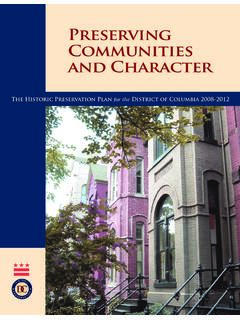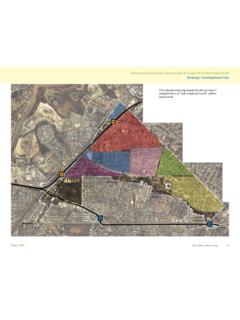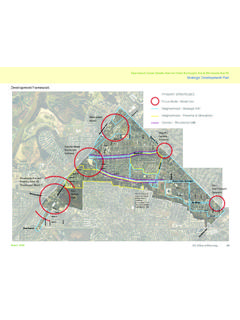Transcription of WALLS AND FOUNDATIONS OF HISTORIC BUILDINGS
1 District of Columbia HISTORIC Preservation Guidelines WALLS AND FOUNDATIONS OF HISTORIC BUILDINGS Government of the District of Columbia Office of Planning HISTORIC Preservation Office 1100 4th Street, SW Suite 650 Washington, DC 20024 202-442-8800 Designs of WALLS and FOUNDATIONS WALLS and above ground FOUNDATIONS are among the most important character-defining elements of HISTORIC BUILDINGS . The design of WALLS and FOUNDATIONS is influenced by the types of materials used, the location, proportions and scale of openings for doors and windows, massing and rhythm of features such as bays and porches, and details and ornamentation.
2 The exterior WALLS of most free-standing BUILDINGS are also structural, that is they carry the weight of the floors and roof to the foundation. Conversely, the front and rear WALLS of rowhouses and other party-wall BUILDINGS are usually not load bearing; rather the side WALLS carry the weight of floors and roofs to FOUNDATIONS . Altering, repairing or replacing primary character-defining WALLS and FOUNDATIONS -those facing major public streets or sidewalks- must be carefully considered so as not to detract from a building's character.
3 Changes to secondary non-character-defining WALLS and FOUNDATIONS (typically on the sides and rear of BUILDINGS ) should also be carefully considered. Greater flexibility in selecting methods of construction and materials is possible for changes to non-character-defining than for character-defining WALLS and FOUNDATIONS . Above ground foundation WALLS are often visually distinguished from the main wall by a change of plane. For example, brick and stone foundation WALLS are often visually separated from the wall above by a belt course of molded brick or shaped stone.
4 In other cases, foundation WALLS are visually distinguished from WALLS by a change of material. The material used for an exposed foundation wall, how it is finished and how it connects to the wall above, are all distinguishing characteristics. Most HISTORIC BUILDINGS in Washington have a primary wall and foundation that face a public street. Typically they significantly contribute to the character of the bui1ding. The primary wall usually contains the front entrance, is formally composed and uses high quality materials.
5 Primary WALLS may also contain elaborate ornamentation and intricate details. secondary, or side and rear WALLS that do not face a major public street, are often less formally composed and may employ lesser quality materials as we" as have less elaborate ornamentation than the primary wall. A belt course is often used at the junction between the wall and above ground foundation. Brick Brick is the most prevalent wall and foundation material in Washington.
6 It is found in a wide variety of sizes, shapes, textures and colors. The most common types of brick are pressed, common, Roman, and utility. Modular and jumbo brick can also be found. Most of Washington's HISTORIC brick was manufactured using iron or steel molds and local clay. However, some of the earliest BUILDINGS were made of hand-made brick formed in wood molds. The molds used to manufacture brick give it its texture, shape and size. The type of clay and the temperature of the kiln during firing gives brick its color and hardness.
7 The manner in which headers and stretchers are used, how the rows are laid (called coursing) and the width, profile and color of the mortar joints also contribute to the character of brick WALLS and FOUNDATIONS . Prior to the 1870 s, most bricks were hand-made in wood molds. Sometimes this brick was fairly porous requiring that it be painted to protect it from the weather. Pressed brick, smoother and more regular in appearance than hand-made brick, was introduced in the 1870s and quickly became a popular building material.
8 Machine made common brick was also introduced around this time. By the 1880s most kilns were fueled by gas allowing much higher temperatures to be achieved and a harder brick to be produced. These bricks had the advantage of being non-porous and thus cou1d usually be left unpainted. However, not all bricks produced by gas-fired kilns were of the same hardness. Bricks stacked in the center of the kiln were less exposed to the heat and thus softer (more porous) than those on the outside of the stack.
9 The softer bricks were frequently used for party- WALLS or rear WALLS , while the hard-fired brick from the outside of the kiln stack was used for primary elevations. Local clay gives the majority of unglazed brick a red color, although brown and gray brick is also found. Glazed brick, which is manufactured by adding glaze to the finished brick and re-firing, can be found in a wide range of colors. WALLS and FOUNDATIONS are laid in different ways. Pressed brick is laid in a running bond.
10 Other types of brick are usually laid in common and Flemish bond. In addition to the coursing, the width, color and profile of mortar joints contribute significantly to the appearance of the wall. Mortar joints vary from 1/8" to 1/2" in width, although other widths exist. Common mortar joint profiles include struck, weather, and flush. Other less common profiles include raked, vee and concave. Mortar is naturally a gray-white color, although some mortar used in HISTORIC brick WALLS and FOUNDATIONS is red or some other color due to the addition of coloring agents.






